Sweeping in France

Sweeping in France |
 |
Bordeaux, Franceby Ranger Kidwell-Ross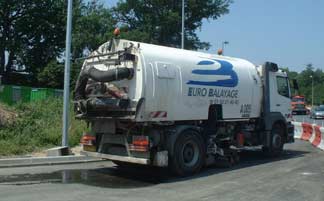
The job site's work-crew was gone and, according to David Passerieux, a state inspector who was taking a look at the construction site, they wouldn't be back for at least half an hour. And, since he'd confirmed that no one on the crew spoke any English whatsoever, I was initially at a loss as to what I might write about. But, an inspiration for a story idea came almost immediately as I approached the rear of the sweeper. It looked as though the hopper, like the rest of the machine, hadn't been truly cleaned in quite a while, though from which day's sweeping the dirt had accumulated was anyone's guess. A steady stream of water was dripping out of the back of the hopper, forming a pool on the otherwise dry pavement. Floating on the water's surface was a rainbow of petroleum effluent and a congealed waxy scum of some kind. Not exactly what you'd want an EPA inspector to see while you're off eating lunch. The surrounding road surface looked clean, so it was clear the petroleum products were coming from the hopper. 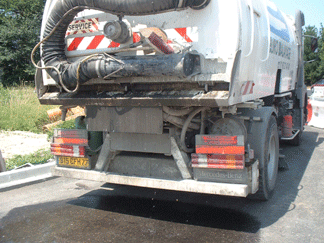
Although the material collected by the sweeper must be dumped at some point, by the time this liquid is removed from the rest of the load, it's far more likely to have become a toxic concentrate. Although, in this instance, it wasn't likely that a child would be along and play in the puddle, since the construction site was next to a busy highway, it was surely a possibility. And, dogs or other animals would certainly be able to drink from it. Looking more closely at the back of the hopper, it appeared that this particular sweeper wasn't being maintained with anywhere near the thoroughness that's needed to ensure a long service life. A thick layer of greasy grime covered the back of the hopper. For arguments' sake, let's say it's possible for that gunk to have accumulated in just one shift. 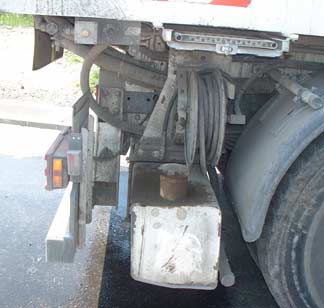
However, looking closer at the rest of the machine, it was apparent that overall maintenance care was lacking. The tops of the tanks, around both fuel tank fillers, were coated with a thick layer of 'petroleum dirt.' The general appearance of the sweeper made me wonder if pressure washers were available in this country, yet, there was (what appeared to be) a high-pressure hose located right on the back of the sweeper. One of the large, air transfer hoses had been patched in two places, using foot long pieces of rubber. Their edges were lined with grommet holes, and were secured together with heavy plastic ties, then applied over the holes in what appeared to be a 10-inch intake or exhaust hose. Although these no doubt helped considerably, in all likelihood, the air continued to leak under the patches. 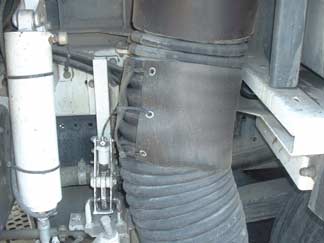
I've never understood why someone would be this 'pound foolish' with a machine whose entire design is tailored to maximize airflow. Patches like these tend to leak, because flat rubber is being used to patch a corrugated rubber surface. Of course, any leakage in the system cuts down on the airflow and, correspondingly, pickup power. Depending on how much leakage occurs around the patch, there can be an increase in the noise level, as well. When there's an air leak, the auxiliary engine has to be run at a higher (noisier) rpm to pick up debris. That, in and of itself, creates more noise than would otherwise be necessary, plus it increases fuel consumption and lessens engine life. There's definitely no long-term payoff in neglecting to replace an intake hose! I decided to take an even closer look at the hose. Mid-point was a circular clamp designed to keep the hose from moving sideways during transport and sweeper operation. The clamp was loose, which allowed the hose to move back and forth, about 4 inches in each direction. The points at which the patches had been applied corresponded to the angled steel 'chassis rub spots.' Had the clamp been kept tight, the hose would have been just fine. 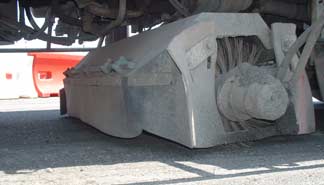
This particular sweeper employed a horizontal broom-in-head. Although these are sometimes necessary, with today's U.S. regenerative air sweepers, they've become the exception, not the rule. If you can find a machine that will do the job without one, eliminate this expensive wear item. Surrounding the motor that powered the transverse broom's operation, was a 6-inch layer of caked-on dirt. One hydraulic hose connection was completely coated, and the other one partly so. This type of neglect can become expensive when the dirt gets into the hydraulics. Sooner or later, contamination will occur. In the meantime, the dirt acts as sandpaper, without the paper, on the hydraulic hose. My guess is that DOT inspections aren't quite as stringent here as they are in the States. The machine's outer rear duals on both sides were bald, and the sidewalls had seen some real scrubbing at some point in their lifetimes. Gutter broom length was okay on both sides, although the head flaps needed some adjustment or, more likely, replacement -- another area where performance was no doubt suffering on this particular air sweeper. Other parts of the sweeper reflected a general pattern of neglect. The tops of both rear fender covers, which were made of plastic, were worn through, leaving flaps of fractured plastic waving over the tires. The areas around the head also needed some good, old-fashioned cleaning, and it appeared that none of the bolt heads on the machine had seen a wrench in recent times, either. This sweeper's condition was an excellent example of why some contractors and municipalities believe that no sweeper will work for very long before something breaks or wears out, while others routinely wring years more service out of the sweepers in their fleet. Many times, as an owner or manager of a sweeper fleet, it's your choice to make. Sometime in the next day or so, I encourage you to take critical look at a unit or two in your fleet. What kind of story does your sweeper tell you? 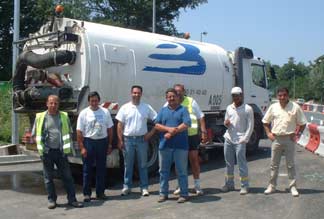
Just as I was about to get back in the car and head into town, the entire work-crew arrived back on the jobsite. I had absolutely no luck in developing real communication with anyone, since the native language all around did, indeed, seem to be Portuguese. However, I hauled out one of our magazine back issues I'd brought along, and did my best to communicate that if they all gathered around the front of the sweeper, they could be part of a story. And now they are! If you'd like, you may view a brief Quicktime movie taken in conjunction with the above story. Note you need to have either Quicktime or another plug-in viewer that will read a .mov file. The movie is advised for only high-speed connections, however, with a filesize of just over 27 megabytes.
|